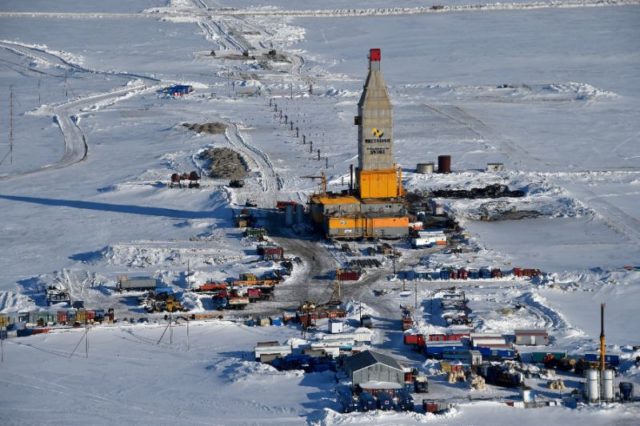
Putin’s Arctic Dream Evolving Into Nightmare?
Publication: Eurasia Daily Monitor Volume: 15 Issue: 45
By:

Russia conceived of the Arctic as a military bastion long before Vladimir Putin rose to power. Yet, since coming to the Kremlin, Putin has explicitly tried to turn the Russian High North into a showcase of his dreams of developing the next Russian “El Dorado.” Official statements and policies have for many years indicated the Arctic is supposed to be Russia’s treasure house for the 21st century as well as a great symbol of Russia’s ideological-political rejuvenation (see EDM, November 1, 2016). At the same time, Putin has showcased the Arctic as a theater for intense development of Russian military capabilities. And he recently boasted that Russia has enough capabilities there to defend the country and to provide for its future development (TASS, March 11). Such confident rhetoric notwithstanding, reality is setting in. And due to the unforgiving economic, political and climactic developments in the Russian Arctic, the dream of rejuvenation is fast receding and may soon be supplanted by a veritable nightmare.
Since 2016, scientific studies have repeatedly shown that the melting permafrost in Russia’s Arctic zone is undermining the infrastructure there and could lead to the collapse of many buildings and pipelines over the next several decades (Siberian Times, December 20, 2016; see EDM, February 13, 2018). This forecast was followed by still other reports indicating that melting glaciers could further inundate Russia’s Far North and Siberia (Russia Beyond the Headlines, March 14, 2017). Yet, Moscow clearly cannot afford to do much about these threats, even as it pours money into military construction and deployments in the Arctic (see EDM, January 24, 2018). For example, in 2017, Russia’s precarious economic situation and stress on the budget forced what amounted to an almost 90 percent cut in state funding for Arctic infrastructure that was originally envisaged to be built by 2020. Thus, the government is asking private transport and energy firms to bail it out to make up the investment needed to bring to fruition the entire government program for transportation to and through the Arctic (Izvestia, March 27, 2017).
Such cuts clearly display the bankruptcy of Putin’s great Arctic dream. And the bad news keeps coming because the military program is ultimately unsustainable if the supporting infrastructure either cannot be built or receives inadequate maintenance and support. Ultimately, therefore, even if Russia’s militarization of the Arctic progresses, it will amount to Moscow throwing money down the drain in the face of a looming environmental catastrophe. In July 2017, after the government slashed its budget, The Siberian Times published a report indicating that there had already been some 700 explosions in the Yamal area—the site of Russia’s new mega pipeline project—due to thawing permafrost (The Siberian Times, July 4, 2017). Such explosions and the dangers of methane gas releases had already been forecast in 2015 (The Siberian Times, September 22, 2015), so this was to be expected.
But in the absence of resources with which to combat the dangers connected with unchecked climate change, Russia’s High North is becoming ever more vulnerable to all manner of ecological threats. This is especially the case as both Russian and American scientists report that the Arctic was unusually warm this past winter; according to researchers from the United States, 2017/2018 was the warmest winter on record in the Arctic (TASS, March 5, 2018; RFE/RL, March 7). So it is hardly surprising that global climate change is now leading to shoreline erosion in northern Russia at the rate of up to four meters a year. And approximately every three days, the region witnesses an accident involving local power stations, oil and gas pipelines, roads, and other infrastructure. Inasmuch as the Arctic and the Northern Sea Route (NSR) are crucial to Russia’s future economic development, and because Moscow has built nuclear power stations and nuclear-powered icebreakers there, the potential for catastrophe in the High North is high. And absent remedial intervention, it will probably increase over time (RIA Novosti, March 11).
The foregoing suggests that, far from being an El Dorado, the Arctic could end up costing far more than Russia can invest to make it a livable flourishing area. Excessive militarization and miscalculations about future energy prices will only exacerbate this situation. Certainly, Russia’s Arctic military installations seem to suffer from some unspecified degree of risk, which will only grow over time. Yet, the means to deal with this problem are simply unavailable for the government; and private firms, even with state direction, will likely not invest enough there to make a difference because of the difficult economic realities in the High North. Thus, over time, the Arctic dream could easily turn into a nightmare for the Kremlin.
It seems increasingly apparent that, over the long run (barring major growth in energy prices, which is rather unlikely), Moscow will not be able to afford either to sustain its civilian infrastructure and population or its defense buildup in the Arctic. If those conclusions are accurate, what will Moscow ultimately have to show for the huge expenditures it has made here?



